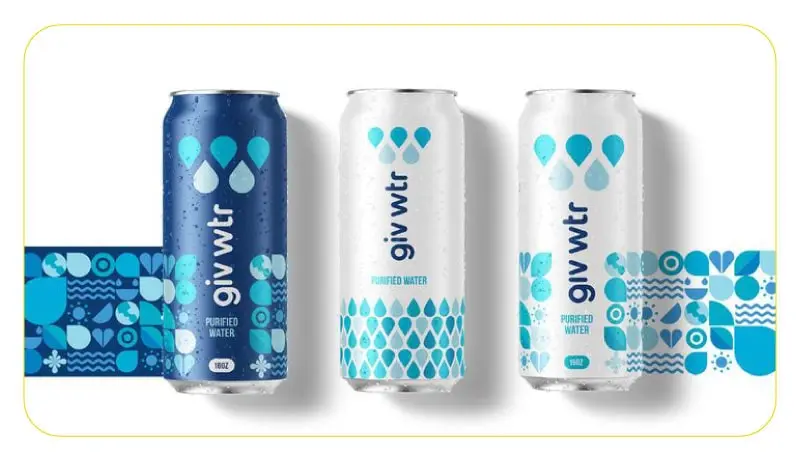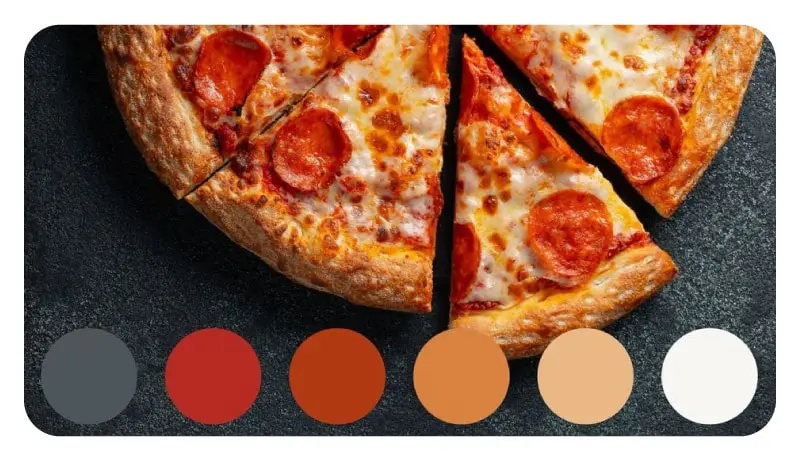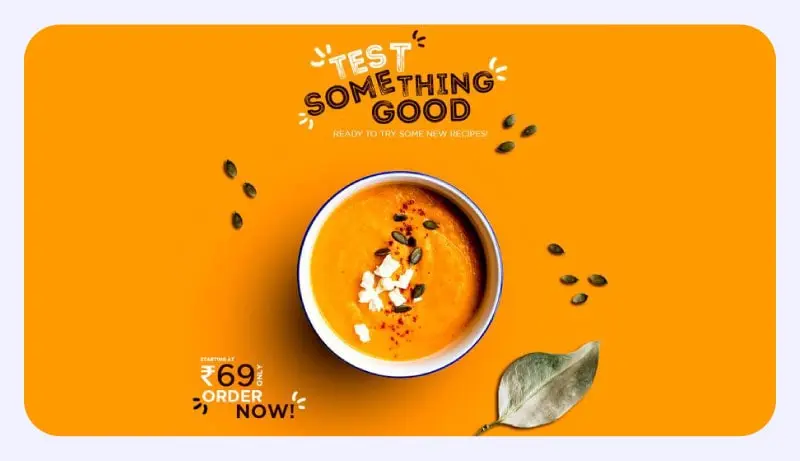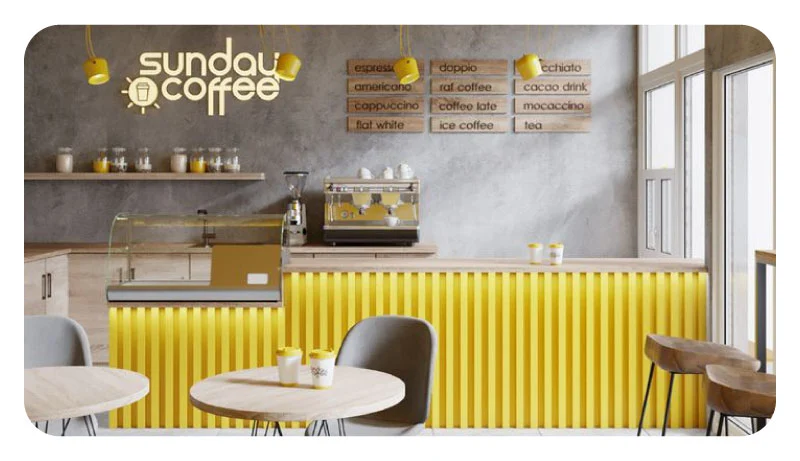In food marketing, the impact of color is undeniable. The right color can make a product stand out on a crowded shelf, entice consumers to take a closer look, and even influence their purchasing decisions. That’s why choosing the best colors for food marketing is so important for food companies and brands.
But it’s not just about selecting any old color. The best colors for food marketing are those that can effectively communicate a brand’s message and connect with its target audience. It’s about understanding color psychology and the associations that people have with certain colors.

In this article, we’ll delve into the world of food marketing and explore the impact of color on consumer behavior. We’ll discuss effective color combinations, explore different types of color palettes, and highlight the best colors for food marketing. Whether you’re a seasoned marketer or just starting out, this article will provide you with valuable insights on how to use color to your advantage in the food industry. So let’s get started and discover the power of the best colors for food marketing.
Color psychology in food advertising
Color psychology is a fascinating field of study that has been used for decades to understand how color affects human behavior and emotions. When it comes to food advertising, color plays a crucial role in influencing consumers’ decision-making processes.
For example, the color red is often associated with excitement, passion, and appetite stimulation. That’s why many fast-food chains use red in their branding and advertising to create a sense of urgency and encourage consumers to make a quick purchase.
Similarly, the color green is associated with health and freshness, making it a popular choice for promoting organic and natural food products. On the other hand, the color yellow is often associated with happiness and warmth, making it a popular choice for snacks and comfort foods.

However, it’s important to note that the meaning and associations of colors can vary across cultures and demographics. That’s why it’s crucial for food marketers to understand their target audience and their cultural background when choosing colors for their branding and advertising.
Moreover, the combination of colors can also play a crucial role in creating a specific mood or emotion. For instance, the combination of blue and green can create a calming and relaxing effect, while the combination of red and yellow can create a sense of excitement and urgency.
Understanding the nuances of color psychology in food advertising can help food marketers create effective advertising campaigns that resonate with their target audience and drive sales. By using the right colors and combinations, food marketers can communicate their brand message and influence consumer behavior in powerful ways.
Effective color combinations for food marketing
Choosing the best colors for marketing your food products is crucial, but it’s not just about selecting one color. Effective color combinations can make a big impact on your marketing efforts and help your brand stand out from the competition.
When it comes to choosing color combinations for food marketing, it’s important to consider your brand identity and target audience. For example, a brand targeting children might use bright and bold colors like red, yellow, and blue, while a brand targeting health-conscious adults might use more muted and natural colors like green and brown.
Another effective approach to choosing color combinations for food marketing is to use color theory. Complementary colors, for example, are colors that are opposite each other on the color wheel and create a striking visual contrast. Analogous colors, on the other hand, are colors that are adjacent to each other on the color wheel and create a more harmonious color scheme.

Here are some examples of effective color combinations for food marketing:
- Red and yellow: This color combination is commonly used in fast food branding and advertising because it creates a sense of excitement and urgency.
- Green and brown: This combination creates a natural and organic feel, making it ideal for promoting healthy and sustainable food products.
- Blue and white: This combination creates a calming and refreshing effect, making it a popular choice for water and beverage brands.
- Purple and gold: This combination creates a sense of luxury and sophistication, making it a good choice for premium food products or brands.
When choosing color combinations for food marketing, it’s important to test different options and gather feedback from your target audience. Ultimately, the best colors for marketing your food products will depend on your brand identity, target audience, and marketing goals.
Color Combinations for Food Packaging and Menus
When it comes to the food business, selecting the right colors for your packaging and marketing materials can make a significant difference in attracting customers and enhancing their dining experience. The psychology of colors plays a crucial role in influencing consumer behavior and perception. Let’s explore some best color options for your food business:
- Appetizing Red: Red is known to stimulate appetite and evoke feelings of excitement and energy. It can be an excellent choice for restaurants or food businesses that want to create a sense of urgency and encourage customers to take action, such as placing an order or trying a new dish.
- Fresh and Natural Green: Green is often associated with nature, freshness, and health. It works well for businesses that focus on organic or healthy food options. Green can also convey a sense of tranquility and balance, making it suitable for establishments that offer a relaxing dining experience.
- Elegant and Sophisticated Black: Black can add a touch of sophistication and elegance to your food business. It can work particularly well for high-end restaurants or gourmet food brands. However, use black sparingly and balance it with other colors to avoid a somber or overly formal ambiance.
- Warm and Inviting Yellow: Yellow is a warm and cheerful color that can create a welcoming atmosphere. It can be an excellent choice for fast-food restaurants or establishments that want to convey a sense of happiness and friendliness.
- Rich and Comforting Brown: Brown is often associated with warmth, comfort, and earthiness. It can work well for businesses that want to emphasize the homemade or rustic nature of their food offerings.
- Versatile Neutrals: Neutrals like beige, cream, and soft gray can serve as a versatile backdrop for your food business. They can complement other colors and provide a clean and contemporary look.
When choosing colors for your food business, consider your brand identity, target audience, and the emotions you want to evoke. It’s essential to strike a balance between aesthetics and functionality. Remember that color consistency across your branding, packaging, and marketing materials can enhance brand recognition and leave a lasting impression on customers. Conducting customer surveys or seeking professional advice from graphic designers can also help you make informed decisions about the best colors for your food business.
Food marketing color palettes
Color palettes play an important role in creating a cohesive and impactful visual identity for food marketing campaigns. A color palette is a set of colors that are used consistently across all branding and advertising materials.
When it comes to choosing a color palette for food marketing, there are several factors to consider. First, you should consider your brand identity and values. Are you a fun and playful brand, or are you focused on health and sustainability? Your brand identity should guide your color palette choices.
Another important consideration is your target audience. Different colors and color palettes can appeal to different age groups, genders, and cultural backgrounds. For example, bright and bold colors might appeal to children, while more muted and natural colors might appeal to health-conscious adults.
There are several types of color palettes that you can choose from for food marketing, including monochromatic, complementary, and triadic. Monochromatic color palettes use variations of a single color, while complementary color palettes use colors that are opposite each other on the color wheel. Triadic color palettes use three colors that are equally spaced on the color wheel.

Here are some examples of food marketing color palettes:
- Monochromatic green: This color palette is ideal for promoting natural and organic food products. Shades of green can evoke feelings of freshness, health, and sustainability.
- Complementary red and green: This color palette creates a strong visual contrast and can be effective for promoting holiday-themed food products or limited-time offers.
- Triadic blue, yellow, and red: This color palette creates a fun and playful vibe and can be effective for promoting children’s food products.
Choosing the right color palette for your food marketing campaign can make a big difference in how your brand is perceived by consumers. By considering your brand identity, target audience, and marketing goals, you can select a color palette that effectively communicates your message and resonates with your customers.
Best colors for food marketing
When it comes to food marketing, choosing the right colors can make a big difference in how your brand is perceived by consumers. Some colors are more effective than others in evoking certain emotions and creating a specific mood. Here are some of the best colors for food marketing and what they can convey:
- Red: Red is an attention-grabbing color that can create a sense of urgency and excitement. It is commonly used in fast food branding and advertising to encourage quick decision-making and impulse purchases. Red can also stimulate appetite and increase heart rate, making it a popular choice for food marketing.
- Green: Green is often associated with health, freshness, and sustainability. It is a great choice for promoting natural and organic food products, as well as products that are environmentally friendly. Green can also create a calming and soothing effect, making it a good choice for promoting relaxation and wellness.
- Yellow: Yellow is a cheerful and optimistic color that can evoke feelings of happiness and warmth. It is commonly used in food marketing to create a sense of playfulness and fun. Yellow can also stimulate appetite and increase feelings of hunger, making it an effective choice for food advertising.

- Orange: Orange is a vibrant and energetic color that can create a sense of excitement and enthusiasm. It is often used in food marketing to promote new products or limited-time offers. Orange can also stimulate appetite and increase feelings of hunger, making it a popular choice for food advertising.
- Brown: Brown is a warm and natural color that can create a sense of comfort and familiarity. It is often used in food marketing to promote products that are homemade or artisanal. Brown can also create a sense of reliability and trustworthiness, making it a good choice for promoting established brands.
- Blue: Blue is a calming and soothing color that can create a sense of trust and reliability. It is commonly used in water and beverage branding and advertising to create a sense of freshness and purity. Blue can also suppress appetite and reduce feelings of hunger, making it an effective choice for promoting diet and weight loss products.
Ultimately, the best colors for food marketing will depend on your brand identity, target audience, and marketing goals. By understanding the psychology of color and how it can influence consumer behavior, you can select colors that effectively communicate your message and resonate with your customers.
Using color to appeal to foodies
Foodies are a unique segment of the market that has a particular passion for food and culinary experiences. When it comes to appealing to this group, the right branding can make all the difference. Choosing the best colors for branding can help you connect with foodies and create a memorable brand identity. Here are some tips for using color to appeal to foodies:
- Use rich and vibrant colors: Foodies are attracted to bold and vibrant colors that reflect the excitement and passion they feel for food. Using rich colors such as deep reds, bright yellows, and vibrant greens can help your branding stand out and catch the eye of foodies.
- Highlight natural ingredients: Many foodies are interested in natural, whole-food ingredients. Using colors that reflect the natural beauty of these ingredients can help you connect with this audience. Shades of green and earth tones are great choices for highlighting natural ingredients and promoting a natural and healthy image.
- Create a sense of luxury: Foodies often associate luxury with high-quality and unique food experiences. Using rich, dark colors such as deep blues and purples can create a sense of luxury and sophistication. Gold and silver accents can also add a touch of elegance and refinement.

- Focus on texture: Texture is a key element of foodie culture. Using colors that convey texture, such as rough textures or grainy patterns, can help create a sense of depth and complexity in your branding. This can help you appeal to foodies who value unique and artisanal experiences.
- Be creative: Foodies are drawn to creativity and innovation in the food industry. Using unexpected color combinations or unique hues can help your branding stand out and create a memorable impression. Don’t be afraid to experiment and try new things.
Overall, the best colors for branding to appeal to foodies are those that evoke a sense of excitement, passion, and creativity. By understanding the preferences and values of this unique segment of the market, you can create branding that resonates with foodies and helps you stand out in a crowded market.
Marketing colors for food
When it comes to marketing food products, the right colors can make all the difference. In fact, studies have shown that up to 90% of snap judgments made about products can be based on color alone. So, choosing the right colors for food marketing can have a significant impact on how your product is perceived and whether or not it stands out on the shelves. Here are some tips for choosing marketing colors for food:
- Consider the product category: Different types of food products have different color associations. For example, blue is often associated with freshness and cleanliness, making it a good choice for seafood and dairy products. Red, on the other hand, is often associated with excitement and indulgence, making it a popular choice for candy and sweets.
- Look at the competition: It’s important to stand out from the competition, but you also want to fit in with your product category. Look at what colors your competitors are using and consider using complementary colors or something that stands out from the crowd.

- Think about the target audience: The colors that appeal to one demographic may not be the same as those that appeal to another. For example, bright and bold colors may be popular with younger consumers, while more muted and natural tones may appeal to health-conscious consumers.
- Consider the packaging material: The color of your packaging should also complement the material it is printed on. For example, matte packaging may look better with more subdued colors, while glossy packaging can handle brighter and more vibrant hues.
- Keep it simple: Too many colors can be overwhelming and confusing for consumers. It’s generally best to stick to a simple color palette with no more than two or three main colors.
Remember, the goal of marketing colors for food is to create a visual identity that is memorable, eye-catching, and consistent with your brand message. By considering the product category, competition, target audience, packaging material, and keeping it simple, you can create a marketing color scheme that stands out from the competition and effectively communicates the unique qualities of your food product.
Conclusion
In conclusion, choosing the best colors for food marketing can make a significant impact on how your product is perceived by consumers. By understanding color psychology and how it influences consumer behavior, and considering factors such as brand identity, target audience, and packaging material, you can create an effective color scheme that not only stands out from the competition but also communicates your brand message and the unique qualities of your food product. Whether you’re designing packaging, creating marketing materials, or developing a brand identity, the right colors can help you connect with your target audience, build brand recognition, and ultimately drive sales.
FAQs
What are the most appealing colors for food marketing?
- The most appealing colors for food marketing depend on the product and target audience, but red, green, and blue are often used as they can stimulate appetite and create a sense of freshness and healthfulness.
How can color affect consumer behavior in the food industry?
Color can affect consumer behavior in the food industry by influencing emotions, creating brand recognition, and increasing sales. For example, warm colors like red can create a sense of excitement and urgency, while cool colors like blue can promote trust and relaxation.
Which colors are best for food businesses?
The best colors for food businesses depend on the brand message, target audience, and product category. However, colors like green, blue, and red are often used as they can communicate freshness, health, and indulgence.
How do you choose the right colors for food packaging design?
To choose the right colors for food packaging design, consider the product category, target audience, and brand identity. It’s also important to choose colors that complement the packaging material and create a visual identity that is consistent with the brand message.
What are some common color associations in food marketing?
Some common color associations in food marketing include red for excitement and indulgence, green for freshness and health, and blue for cleanliness and relaxation. However, the associations can vary depending on the product category and target audience.







 Facebook Ads Spy Tool
Facebook Ads Spy Tool TikTok Ads Spy Tool
TikTok Ads Spy Tool
2 thoughts on “What Are The Best Colors For Food Marketing?”
I’m starting a food business and I’m wondering what colors would be the best choice for my branding and packaging. Any suggestions?
Choosing the best colors for your food business is crucial as it can significantly impact the perception and appeal of your products. When it comes to the best colors for food businesses, it’s essential to consider the emotions and associations that different colors evoke. Warm and appetizing colors like red and orange can stimulate hunger and excitement, while fresh and natural colors like green can convey a sense of health and freshness. Ultimately, it depends on your target audience and the message you want to convey with your brand. Don’t hesitate to experiment with various color combinations to find the perfect match that reflects your unique identity and delights your customers.